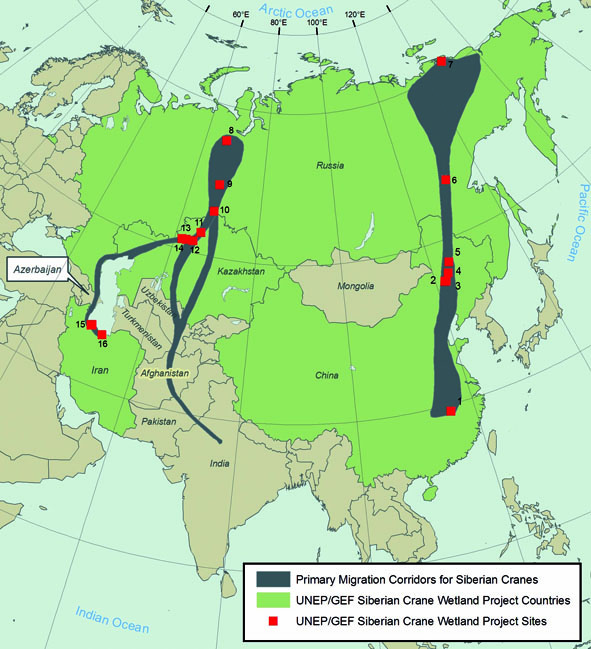Program Overview

In 2003 the International Crane Foundation (ICF), in collaboration with the governments of China, Iran, Kazakhstan, and Russia launched the UNEP/GEF Siberian Crane Wetland Project (SCWP). The SCWP was coordinated through the United Nations Environmental Programme, as Implementing Agency of the Global Environment Facility grant, in cooperation with the Convention on Migratory Species. The seven-year project has focused on protecting a network of globally important wetlands in Eurasia that are of critical importance for migratory waterbirds and other wetland biodiversity. The project uses the critically endangered Siberian Crane (Grus leucogeranus) as a flagship species, linking activities at 16 key wetlands along the species’ western and eastern flyways.
SCWP has been the first full-size flyway project funded by GEF. Its lessons have wide applicability to future projects that address conservation issues at a flyway scale. The project ended on December 31, 2009. This project has functioned at three levels.
At the site level, activities aimed to improve management effectiveness, reduce external threats and ensure necessary water flows to maintain the ecological health of wetlands. Activities included strengthening legal protection and enforcement, training nature reserve staff, involving local communities, and developing site management plans, environmental education and public awareness programs, and projects that promoted sustainable livelihoods for local communities.
At the national level, the SCWP supported monitoring, training, education and public awareness programs across sites, and applied research to inform sound management decisions, including ongoing study of seasonal waterbird movements and wetland system dynamics. SCWP also worked to improve legislation, policy and planning to support wetland and waterbird conservation. These activities were coordinated with other national wetlands initiatives to strengthen integrated wetland management through collaboration with different organizations.
At the international level, the focus has been on flyway-level conservation – the network of wetland sites along the entire migratory pathways of the cranes. SCWP has promoted cooperation among the four countries, enhanced interaction among sites and engaged communities in the management of the wetlands along the West/Central and East Asian flyways for migratory waterbirds.
Conservation actions within these flyways were coordinated with other initiatives for migratory waterbirds, including the East Asian – Australasian Flyway Partnership and its Crane Working Group, and closely integrated with the Conservation Plans created through the CMS Memorandum of Understanding Concerning Conservation of the Siberian Crane. Collaborative events such as international workshops were organized with these bodies.
Global Biodiversity Importance
Wetlands selected for project intervention all meet the Ramsar Convention’s criteria for Wetlands of International Importance. The flyways used by the Siberian Cranes are shared by at least 27 globally threatened waterbird species. These flyway site networks sustain millions of migratory waterbirds along their migrations, which span the Asian continent. These wetlands are also of considerable socio-economic and cultural importance, supporting the livelihoods of local communities, as well as contributing to regional development.
Major Achievements
• Monitoring of migratory cranes and other waterbirds has been significantly enhanced in both far eastern Russia and eastern China (China, for example, involved 18 organizations at 158 sites over five years).
• Exchange of scientific information and researchers has enhanced international collaboration on the Siberian Crane flyways. Public education efforts created a network of committed teachers, students, and community members near key waterbird sites along the flyways.
• Management and staff capacity at participating sites has been strengthened through development of management plans, community co-management committees, establishment of monitoring programs, and activities to address specific threats such as cooperation with oil and energy companies, and pilot projects to integrate community development with natural resource protection.
• Water management plans have been created in response to severe water shortages at four sites in northeast China and integrated into regional and national water plans. At Zhalong, a long-term funding mechanism has been created for delivery of water to sustain wetland ecological functions, setting a national precedent. Financing has also been committed for water releases at Momoge over three years.
• Research at Poyang Lake linking waterbirds, aquatic food plants and water levels has enabled the evaluation of impacts of water management proposals on waterbirds and wetlands, and supported consideration of alternative actions to integrate ecological and economic benefits of wetlands.
Future Action
Long-term sustainability of project results has been prepared through the increased capacity and training of staff at site and national levels, and by developing regular funding mechanisms through national programs and non-governmental organizations including ICF. Coordination of flyway scale efforts will continue via the East Asian – Australian Flyway Partnership and its working groups, and through the CMS Memorandum of Understanding Concerning Conservation of the Siberian Crane, that involves all 11 range states for the species. Among other evolving threats, future projects will need to focus on adaptive management of wetland ecosystems to cope with climate change and often diminishing water resources for both wildlife and human populations – threats that are particularly acute in areas such as Northeast China.
More information
For more information visit SCWP website
SCWP Final Report [PDF 9,638 KB] and SCWP Completion Workshop Proceedings can be downloaded or you may request copies on CD.


